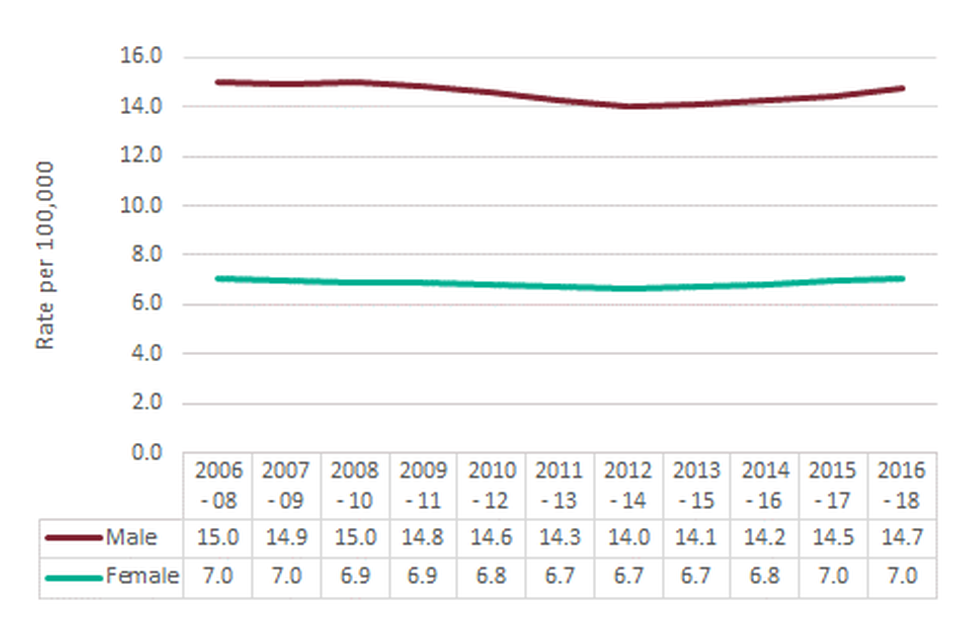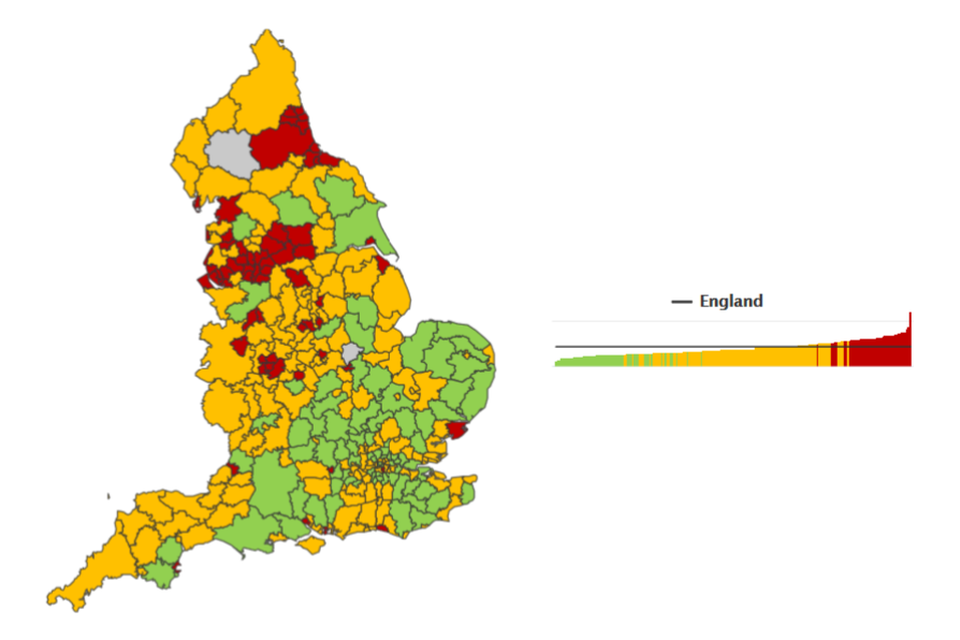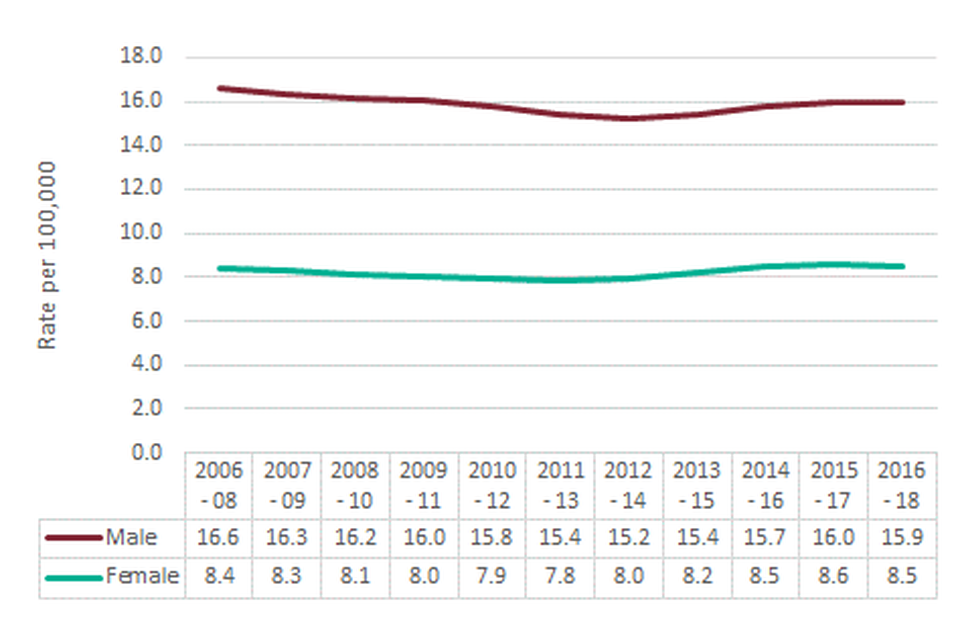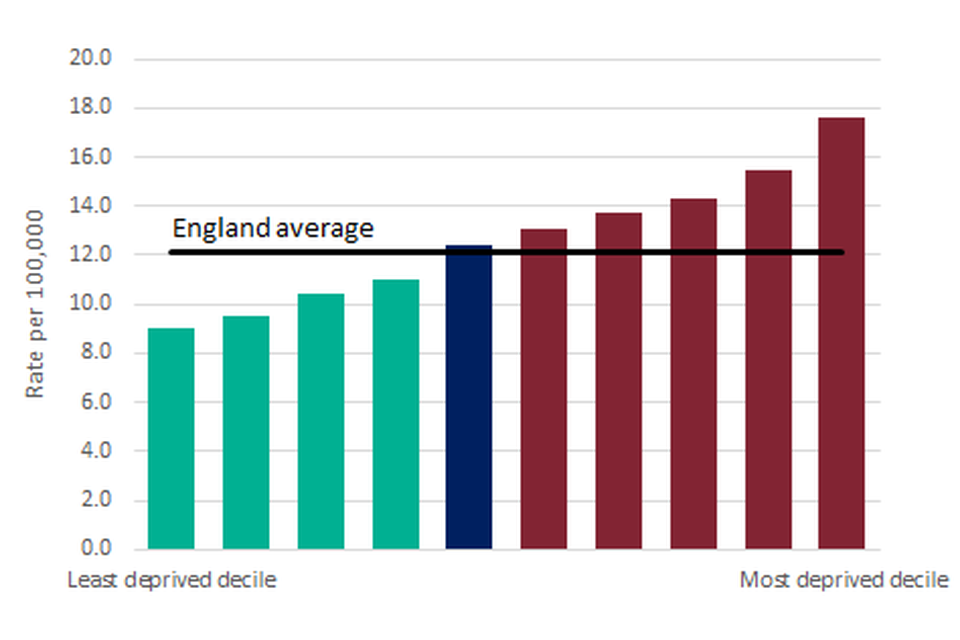Local Alcohol Profiles for England: short statistical commentary, January 2020
Published 14 January 2020
New in this update
New mortality data for 2018 has been added to the Local Alcohol Profiles for England (LAPE) tool on the Fingertips platform. The following indicator has been updated and is available at local authority level as well as for England, the regions, and various inequality groups:
- Years of life lost due to alcohol-related conditions
The following related indicators were updated in December, but with commentary included in this release:
- alcohol-specific mortality
- mortality from chronic liver disease
- alcohol-related mortality
Main findings
- there were over 314,000 potential years of life lost in 2018 related to alcohol consumption, and the rate has increased to its highest level since 2011
- there were 17,040 alcohol-specific deaths in England between 2016 and 2018, an increase in the rate to 10.8 (per 100,000). This is the third successive increase observed
- the rate of deaths from chronic liver disease is 12.1 (per 100,000), equating to 19,000 deaths between 2016 and 2018
- in 2018 there were an estimated 24,720 deaths related to alcohol use in England. The rate has increased for the second consecutive period to 46.5 (per 100,000)
- gender and inequality gaps persist across the updated measures showing that disproportionate levels of harm are impacting on men and the most deprived
Key definitions used in this release
Years of life lost due to alcohol-related conditions
The number of years of life lost up to the age of 75 for individuals who died aged under 75 of an alcohol-related cause.
Alcohol-specific mortality
Deaths from conditions wholly caused by alcohol. This definition is also used by the Office for National Statistics in their annual UK data release.
Mortality from chronic liver disease
Deaths from chronic liver disease, including cirrhosis, classified by an underlying cause of death with ICD10 code K70, K73 or K74.
Alcohol-related mortality
Deaths from conditions which are wholly or partially caused by alcohol. For partially attributable conditions, a fraction of the deaths are included based on the latest academic evidence about the contribution alcohol makes to the condition.
Summary of updated indicators
Years of life lost due to alcohol-related conditions
In 2018 there were over 314,000 years of life lost due to alcohol-related conditions in England up to the age of 75.
The rate of years of life lost increased from 623 (per 100,000) in 2017 to 637 (per 100,000) in 2018. This is the highest the rate has been since 2011.
The rate of years of life lost is significantly higher for males (926 per 100,000) than it is for females (353 per 100,000).
Figure 1: years of life lost due to alcohol-related conditions by gender, England

Figure 1: Years of life lost due to alcohol-related conditions by gender, England !!1
The inequality gradient is particularly steep for years of life lost due to both a higher rate of alcohol-related deaths in more deprived areas and a younger average age at death. Nearly half (48.6%) of the years of life lost in 2018 were among the most deprived 30%.
Figure 2: years of life lost due to alcohol-related conditions by deprivation decile, England, 2016 to 2018

Figure 2: Years of life lost due to alcohol-related conditions by deprivation decile, England, 2016 to 2018
Alcohol-specific mortality
There were 17,040 alcohol-specific deaths in England between 2016 and 2018. This equates to a rate of 10.8 (per 100,000) and is the third successive increase observed.
The female rate remained static (7.0 per 100,000) while the male rate (14.7 per 100,000) increased for the fourth successive period. Consequently, the number of alcohol-specific deaths between 2016 and 2018 for men (11,370) is double the figure for women (5,680).
In addition, the rate of alcohol-specific deaths in the most deprived decile (16.1 per 100,000) is double the rate observed in the least deprived decile (6.9 per 100,000).
Figure 3: alcohol-specific mortality by gender, England

Figure 3: Alcohol-specific mortality by gender, England
Figure 4 shows the variation in alcohol-specific mortality rates across local authorities in England, ranging from 3.2 (per 100,000) in Mid Suffolk to 29.8 (per 100,000) in Blackpool, an almost ten-fold difference.
Figure 4: alcohol-specific mortality, district and unitary authorities in England, 2016 to 2018

Figure 4: Alcohol-specific mortality, district and unitary authorities in England, 2016 to 2018
Mortality from chronic liver disease
There were 19,000 deaths from chronic liver disease between 2016 and 2018. The rate has fallen slightly to 12.1 (per 100,000) in the latest period from 12.2 (per 100,000) between 2015 and 2017.
The female rate (8.5 per 100,000) and the male rate (15.9 per 100,000) both show minor reductions in the latest period. Again, the number of deaths from chronic liver disease between 2016 and 2018 for men (12,100) was almost double the number for women (6,900).
Figure 5: mortality from chronic liver disease by gender, England

Figure 5: Mortality from chronic liver disease by gender, England
The rate of chronic liver disease mortality in the most deprived areas (17.6 per 100,000) is almost double the rate in the least deprived (9.1 per 100,000).
Figure 6: mortality from chronic liver disease by deprivation decile, England 2016 to 2018

Figure 6: Mortality from chronic liver disease by deprivation decile, England 2016 to 2018
Alcohol-related mortality
In 2018 there were an estimated 24,720 deaths related to alcohol use in England. The rate has increased for the second consecutive period to 46.5 (per 100,000) in 2018.
As seen in many other alcohol indicators, there is a marked and persistent gender inequality observed for alcohol-related mortality – the rate for men (67.2 per 100,000) is currently more than double the rate for women (28.7 per 100,000).
Figure 7: alcohol-related mortality by gender, England

Figure 7: Alcohol-related mortality by gender, England
The contribution that alcohol makes to mortality varies considerably by age. Whilst there are a greater number of alcohol-related deaths at older ages, as a proportion of all deaths alcohol is most significant for younger adults.
Figure 8 shows the variation in alcohol-related mortality rates across local authorities in England, ranging from 26.9 (per 100,000) in Harrow to 86.1 (per 100,000) in Blackpool, a difference of over 3 times.
Figure 8: alcohol-related mortality, district and unitary authorities in England, 2018

Figure 8: Alcohol-related mortality, district and unitary authorities in England, 2018
Background and further information
The LAPE have been published on an annual basis since 2006. These profiles have been designed to help local government and health services assess the effect of alcohol use on their local populations. They will inform commissioning and planning decisions to tackle alcohol use and improve the health of local communities.
The LAPE data tool helps local areas assess alcohol-related harm and monitor the progress of efforts to reduce this.
View the LAPE Profile
Definitions and methodology for all LAPE indicators are described in the user guide.
Hospital admissions update: February 2020
The HES-based indicators are scheduled for update in February 2020. At the same time as the LAPE indicators are updated the ‘Alcohol-related hospital admissions – Statistical tables for England’ (formerly produced by the HSCIC) will also be updated.
The February 2019 version is available.
Responsible statistician, product lead: Mark Cook.
For queries relating to this publication contact lape@phe.gov.uk
